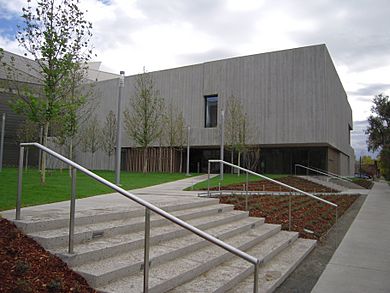Clyfford Still facts for kids
Quick facts for kids
Clyfford Still
|
|
|---|---|
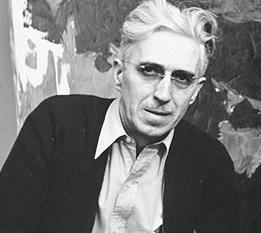 |
|
| Born |
Clyfford Elmer Still
November 30, 1904 |
| Died | June 23, 1980 (aged 75) |
| Resting place | Pipe Creek Church of the Brethren Cemetery, Union Bridge, Maryland |
| Nationality | American |
| Education | Spokane University, Washington State University |
| Known for | Painting |
| Movement | Abstract expressionism, Color Field painting |
| Spouse(s) | Lillian August Battan Still (c. 1930 – late 1940s) Patricia Alice Garske Still (1957–1980) |
Clyfford Still (born November 30, 1904 – died June 23, 1980) was an American painter. He was a very important artist in the first group of Abstract Expressionists. These artists created a new, strong way of painting after World War II.
Still helped start the Abstract Expressionism movement. He began painting in an abstract way between 1938 and 1942. This was earlier than other famous artists like Jackson Pollock and Mark Rothko. They continued to paint more realistic or surrealist styles until the 1940s.
Contents
About Clyfford Still
His Early Life and Education
Clyfford Still was born in 1904 in Grandin, North Dakota. He grew up in Spokane, Washington and Bow Island in southern Alberta, Canada. In 1925, he visited New York City. He studied briefly at the Art Students League.
He went to Spokane University from 1926 to 1927. He returned in 1931 with a special scholarship and graduated in 1933. That fall, he became a teacher at Washington State College. This school is now Washington State University. He earned his Master of Fine Arts degree there in 1935. He taught at the college until 1941.
Starting the Nespelem Art Colony
In 1937, Still helped start the Nespelem Art Colony. He worked with Worth Griffin, a colleague from Washington State. For four summers, they created many portraits and landscapes. These paintings showed the life of Colville Indian Reservation Native Americans.
Moving to California and New York
In 1941, Still moved to the San Francisco Bay area. He worked in different war industries while still painting. His first solo art show was at the San Francisco Museum of Art in 1943. This museum is now the San Francisco Museum of Modern Art.
He taught at the Richmond Professional Institute from 1943 to 1945. This school is now Virginia Commonwealth University. After that, he moved to New York City.
Meeting Other Artists
Still met Mark Rothko in California in 1943. Rothko introduced him to Peggy Guggenheim. She was a famous art collector. She gave Still a solo exhibition at her gallery, The Art of This Century Gallery, in 1946.
The next year, Guggenheim closed her gallery. Still, Rothko, and other Abstract Expressionists joined the Betty Parsons gallery.
Later Life and Moving Away from the Art World
Still went back to San Francisco. He became a very important professor at the California School of Fine Arts. This school is now the San Francisco Art Institute. He taught there from 1946 to 1950.
In 1950, he moved back to New York City. He lived there for most of the 1950s. This was when Abstract Expressionism was very popular. However, Still became unhappy with the art world. In the early 1950s, he stopped working with commercial art galleries.
In 1961, he moved to a farm in Westminster, Maryland. This move took him further away from the art world. He used a barn on his property as his art studio. In 1966, Still and his second wife bought a house in New Windsor, Maryland. He lived there until he died.
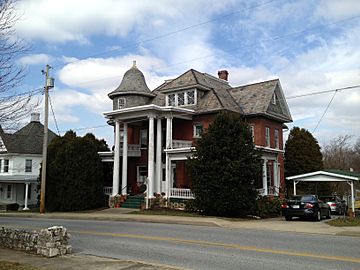
His Family Life
Still married Lillian August Battan around 1930. They had two daughters. They separated in the late 1940s and divorced in 1954.
In 1957, Still married Patricia Alice Garske. She had been one of his students at Washington State University. She was sixteen years younger than him.
Clyfford Still's Paintings
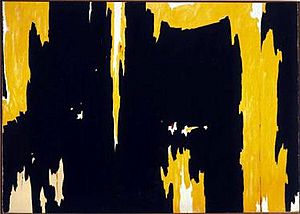
Still developed his unique painting style between 1946 and 1950. This was while he taught at the California School of Fine Arts. He is known as one of the most important Color Field painters. His paintings are not realistic. They focus on putting different colors and textures next to each other.
Unlike artists like Mark Rothko or Barnett Newman, Still's color arrangements are less regular. He combined Color Field painting with Action Paintings. His sharp, jagged areas of color make it look like one layer of paint has been "torn" away. This reveals the colors underneath.
Still also used thick paint, called impasto. This created subtle changes and shimmering effects on his painting surfaces. His large, mature works remind people of natural forms. They can look like ancient caves, plants, or light and darkness.
By 1947, he was using the large-scale style he would use for the rest of his career. He applied paint with palette knives. One famous painting is 1957-D No. 1 (1957). It is mostly black and yellow, with white and a little red. These colors, and shades of purple and dark blue, are common in his art.
Exhibitions of His Work
Still's first solo show was in 1943 at the San Francisco Museum of Art. In 1947, he had another solo show at the California Palace of the Legion of Honor.
From 1952 to 1959, Still chose not to show his art publicly. A big show of his work happened at the Albright–Knox Art Gallery in Buffalo, New York, in 1959. Later shows were held in Philadelphia in 1963 and New York in 1969-1970.
In 1975, some of his works were permanently displayed at the San Francisco Museum of Modern Art. In 1979, New York's Metropolitan Museum of Art held the largest show of Still's art. It was the biggest show the museum had ever given to a living artist.
Awards He Received
Still received the Award of Merit for Painting in 1972. This was from the American Academy of Arts and Letters. He became a member of this academy in 1978. He also received the Skowhegan Medal for Painting in 1975.
Clyfford Still's Estate and Museum
His Will and the Museum Idea
In 1978, Still wrote his will. He left many of his artworks and personal papers to his wife, Patricia. He also stated that his remaining artworks should go to an American city. This city had to agree to build a special place just for his art. The art could never be sold or given away. It had to stay in that place forever for people to see and study.
After Still died in 1980, his collection was kept private for over twenty years. It included about 2,400 works.
The Clyfford Still Museum in Denver
In August 2004, the city of Denver, Colorado, was chosen by Patricia Still. Denver would receive the artworks from the Clyfford Still Estate. This included about 825 paintings and 1575 works on paper.
The The Clyfford Still Museum opened in November 2011. It is an independent, non-profit organization. The museum also holds all of Still's sketchbooks, journals, and other personal papers. Patricia Still left these to the museum when she died in 2005.
The museum building was designed by Allied Works Architecture. It is known as a great example of modern architecture. In March 2011, a court allowed four of Still's works to be sold. These sales helped create an endowment for the museum. This money helps support the museum and its collection.
In December 2011, a visitor was accused of damaging one of Still's oil paintings at the museum.
In 2013, the Clyfford Still Museum Research Center was started. It aims to study the art and history of the time when Still was painting.
Other Places to See His Art
You can find Clyfford Still's paintings in many other important art collections, including:
- Albright–Knox Art Gallery, Buffalo, New York (33 paintings)
- San Francisco Museum of Modern Art (30 paintings)
- Metropolitan Museum of Art, New York (12 paintings)
- Hirshhorn Museum and Sculpture Garden, Washington, D.C. (8 paintings)
- Solomon R. Guggenheim Museum, New York
- The Phillips Collection, Washington, D.C.
- Whitney Museum of American Art, New York
- Tate collection, London
- Governor Nelson A. Rockefeller Empire State Plaza Art Collection, Albany, New York
- The Kreeger Museum, Washington, D.C.
- Glenstone, Potomac, Maryland
- Wadsworth Atheneum Museum of Art, Hartford, Connecticut
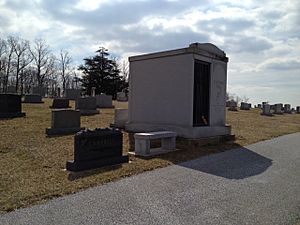
Famous Quotes
From Clyfford Still
- "I never wanted color to be color. I never wanted texture to be texture, or images to become shapes. I wanted them all to fuse together into a living spirit."
- "It's intolerable to be stopped by a frame's edge."
- "I am not interested in illustrating my time. A man's 'time' limits him, it does not truly liberate him."
From Other Artists and Critics
- "Still makes the rest of us look academic." --Jackson Pollock
- "His show... was the most original. A bolt out of the blue. Most of us were still working through images ... Still had none."--Robert Motherwell
- "When I first saw a 1948 painting of Still's ... I was impressed as never before by how estranging and upsetting genuine originality in art can be."--Clement Greenberg, art critic
- "With their crude palette-knifed and troweled surfaces, their immense space, their strong color, their relentless vertical and horizontal expansiveness, Still's abstract works project a forcefulness perhaps unequaled in Abstract Expressionist painting."
- --Stephen Polcari, art historian
See also
 In Spanish: Clyfford Still para niños
In Spanish: Clyfford Still para niños
- List of single-artist museums


